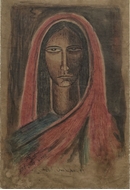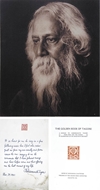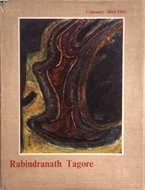![]() Significant Indian Art
Significant Indian Art
![]() Significant Indian Art
RABINDRANATH TAGORE (1861 - 1941)
Significant Indian Art
RABINDRANATH TAGORE (1861 - 1941)
RELATED LOTS
CONTACT US
Catalogue & Viewing
Lot Closed
Accounts & Shipping
Lot Closed
-
Provenance
 Provenance
Provenance
Acquired directly from Rabindranath Tagore by artist Sarada Charan Ukil and thence by descent with his grandson. Subsequently acquired by the present owners from him in 2009.
-
Literature
 Literature
Literature

The present work by Rabindranath Tagore, Nritya from 1933, is a drawing that he had designed for the cover of a volume dedicated to dance. The text for the book was prepared by his daughter-in-law Pratima Devi, wife of Rathindranath Tagore.
The daughter of Binayini Devi, sister of Gaganendranath and Abanindranath Tagore, Pratima had been widowed at a very young age. On Rabindranath’s persistence she was married to his eldest son, making it the first instance of widow-marriage in the Tagore family.
Pratima was raised in the eclectic environs of a family of artists, and had a keen sense of aestheticism. As the able daughter-in-law of Rabindranath, she developed her mental and spiritual faculties under his guidance. Letters written by him to the young bride show how anxious he was that her personality should outgrow the narrow mould in which women were kept. Rabindranath personally supervised her education, recommending books for her to read. One of the first students of the Vichitra club, Pratima had learnt painting from Nandalal Bose and honed her skills in varied craft forms, all of which she incorporated later in the curriculum development of Silpa Sadan in Santiniketan.
Contented by her dedication to the arts, Rabindranath summoned Pratima to assist him in the production of dance-dramas and plays. She was invariably consulted for costumes and stage-designing in a performance.
Tagore was a Titan, but the environment in which he manifested his genius was also competent enough to foster his creativity in whichever way he chose. From the mid- 1920s he had started formalising Santiniketan's dance genre by introducing folk forms and Indian classical dance styles into the curriculum. His associates travelled all over the country in research of various indigenous dance forms and on return, briefed them to Tagore and Pratima. It is indeed a revelation to know of the pioneering creativity propelled by Tagore and his confidantes like Pratima Devi and others.
Nritya, the drawing by Tagore was perhaps made to commemorate this vital research work, with a fitting cover-page by none other than the bard himself. Stylistically the work follows the angular formative patterns evinced in many of Tagore’s works. With swift movement of the pen nib he carves out the pliant figures of the dancers, their motions enhanced by the flowing skirts reminiscent of the mystic Sufi dancers. The structured division of space evokes the essence of a stage, the podium for a dancer’s creativity.
FOR MORE - REFER AUCTION CATALOGUE
-
Notes
 Notes
Notes

National Art Treasure. Non-Exportable
-
Condition
 Notes
Notes
 Extensive pinholes
Extensive pinholes









